The mushroom with the cutest name award goes to – Hedgehogs! Hedgehog mushrooms (Hydnum sp.) aren’t just cute; they’re also an easy beginner mushroom and absolutely delicious. Hedgehog mushrooms have a sweet, nutty flavor, and they retain their dense texture during cooking. One of the best things about this group of mushrooms, though, is that they have no poisonous lookalikes.
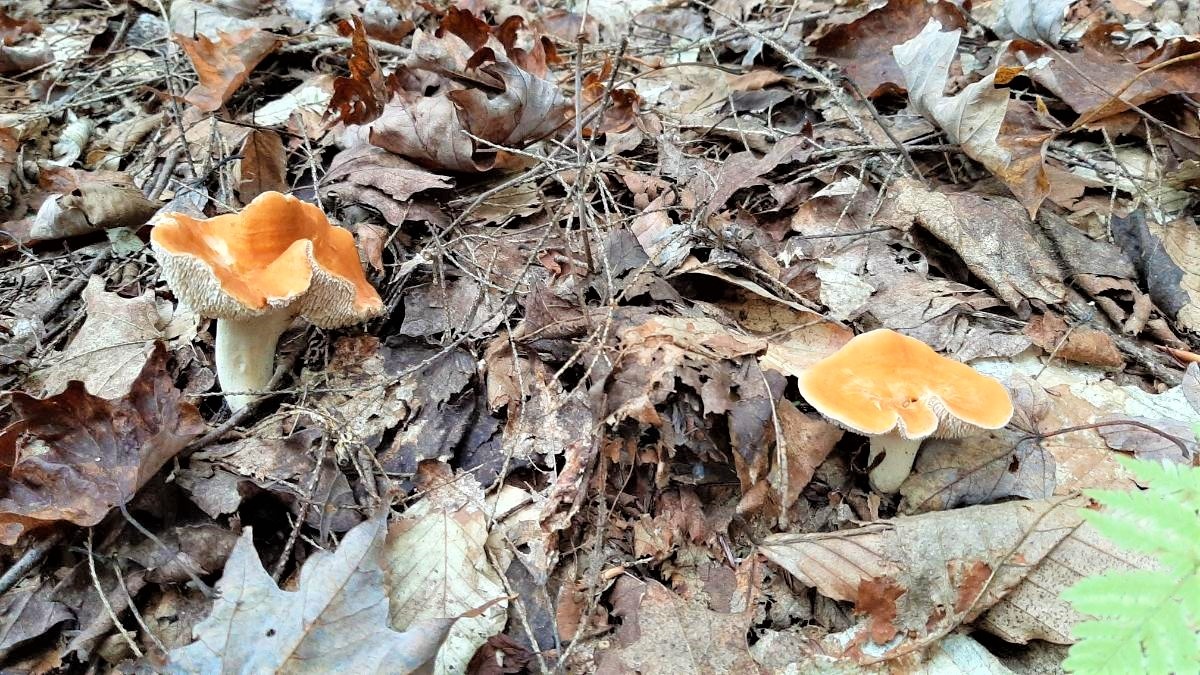
You don’t have to know all the species of hedgehog mushrooms to enjoy foraging and eating them. But, if you want to nerd out a little, there’s a list of documented North American species at the end of this guide. Many of these species are newly named as of 2018.
These newly named fungi were not unknown to foragers since hedgehogs have been a popular edible for centuries. But, now, the differences between the species are being classified.
Looking for recipes? Check out our in-depth guide: How to Prepare Hedgehog Mushrooms: Cleaning, Prepping, and Cooking.
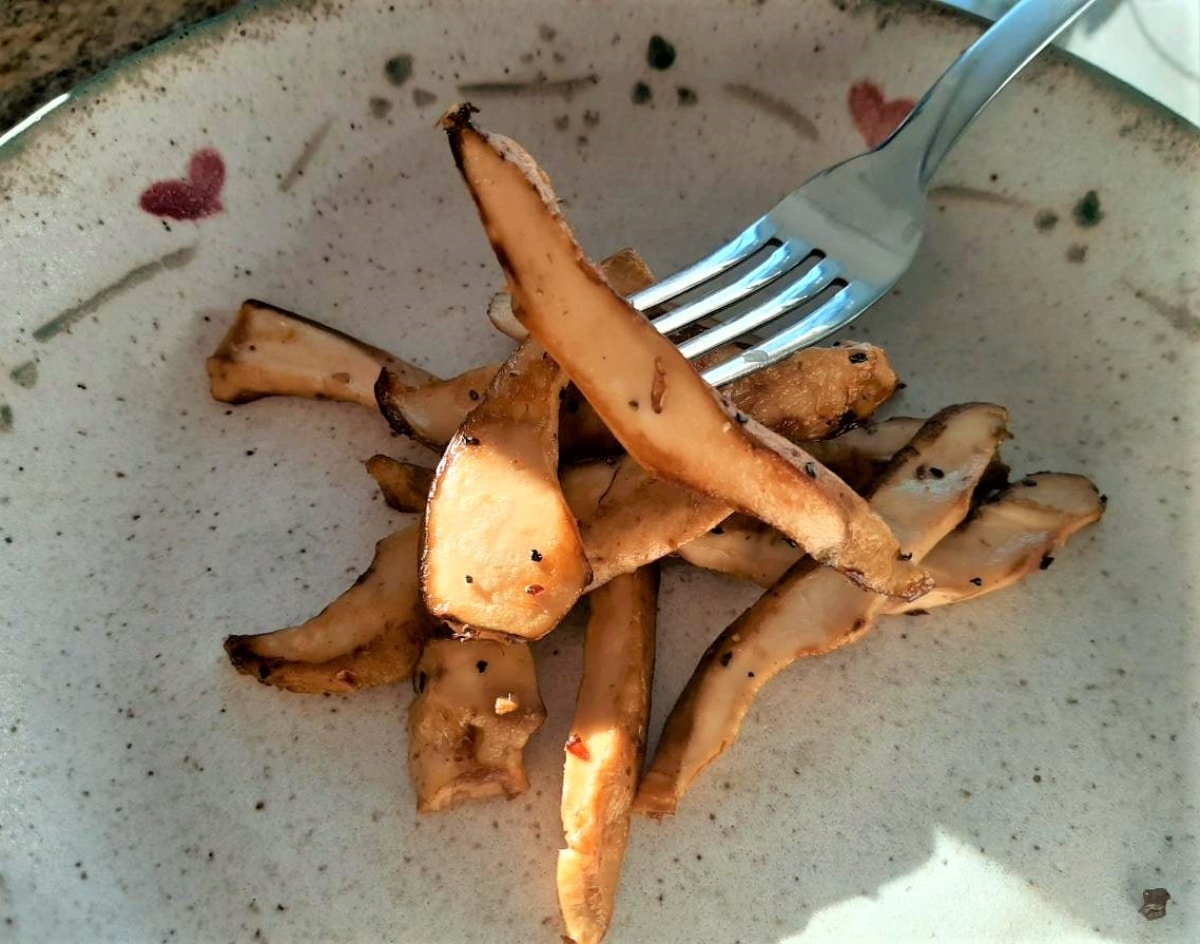
Even if you don’t care about the scientific names, it is good to have a basic knowledge of the hedgehogs that grow near you. There could be 5-10 species in your forests, depending on where you live. And, each one may have a different habitat preference and emergence time. The species list is helpfully divided into east coast and west coast for North America.
Name clarification: Another species of mushroom shares the common name hedgehog. Lion’s Mane (Hericium sp.) is also referred to as a hedgehog – it has spines, too, but looks nothing like the Hydnum hedgehog mushrooms.
Jump to:
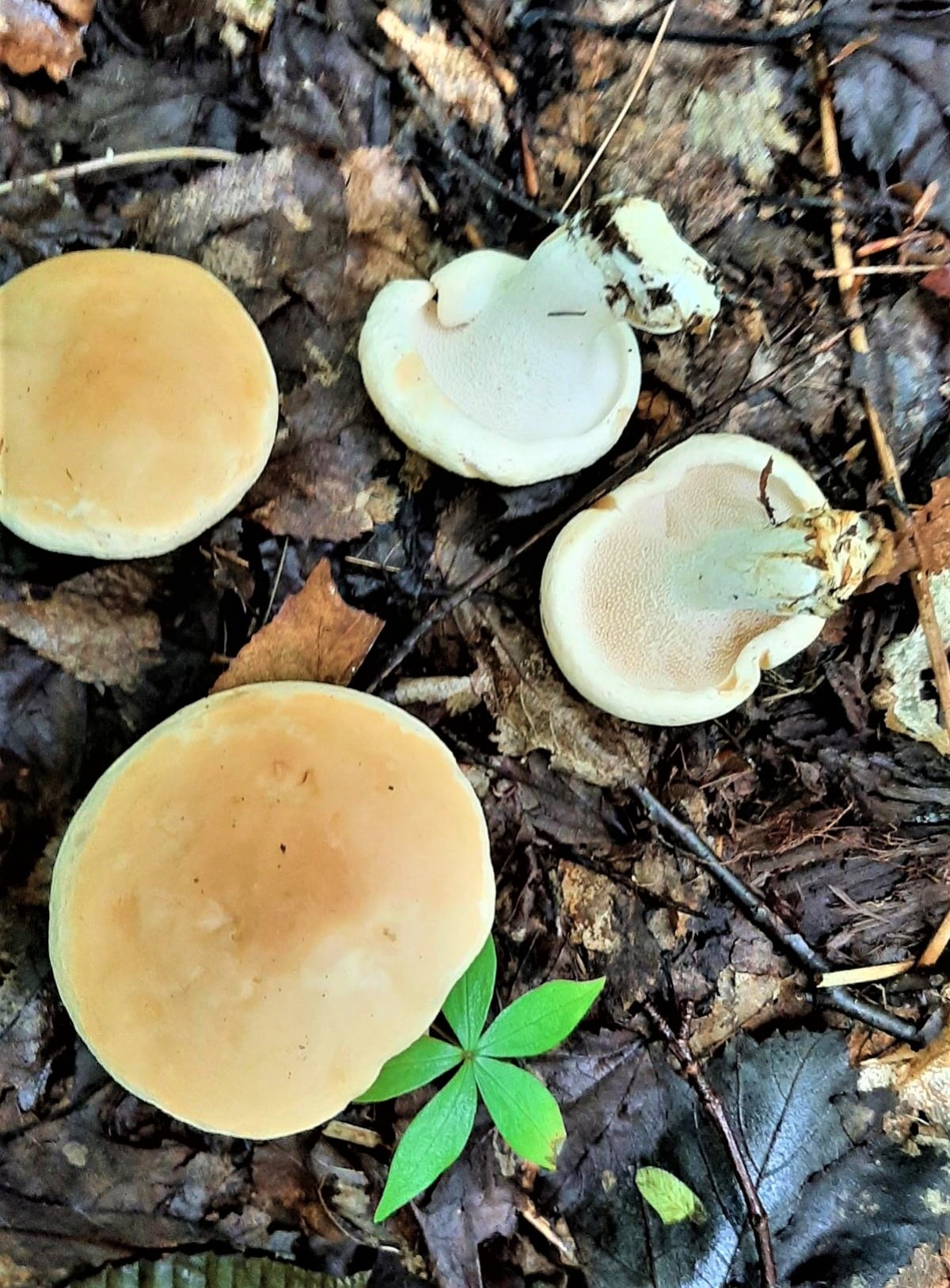
Hedgehog Edibility
All Hedgehog mushrooms are edible in the basic sense – they aren’t toxic and won’t kill you. However, some are bitter and not at all enjoyable. Bitterness may also develop as the mushroom matures. You can do an easy field test to determine whether you’ve found a culinary treasure or bitter disappointment.
The Nibble Test
- Bite a tiny piece of the cap off and let it sit on your tongue. You’ll know if it’s bitter very quickly. Spit the piece out – don’t eat the raw mushroom even if it’s not bitter.
- This is an excellent method to determine edibility in the field when you’re dealing with a non-toxic species. Don’t do this with all mushrooms or species – you have to be clear on your identification before taking a nibble.
All About Hedgehog Mushrooms
The most distinguishable aspect of Hedgehogs is that they have teeth underneath their caps instead of gills. The teeth are short and brittle, like tiny little icicles hanging down. They’re also called spines.
Hedgehog mushrooms are also known as “sweet tooth,” “wood hedgehogs,” or just “tooth fungi.” All Hedgehog species are ground dwellers. These mushrooms are short and stout, growing close to the ground in association with trees; the exact relationship is still being explored. Most species grow in mixed forests or conifer-only forests.
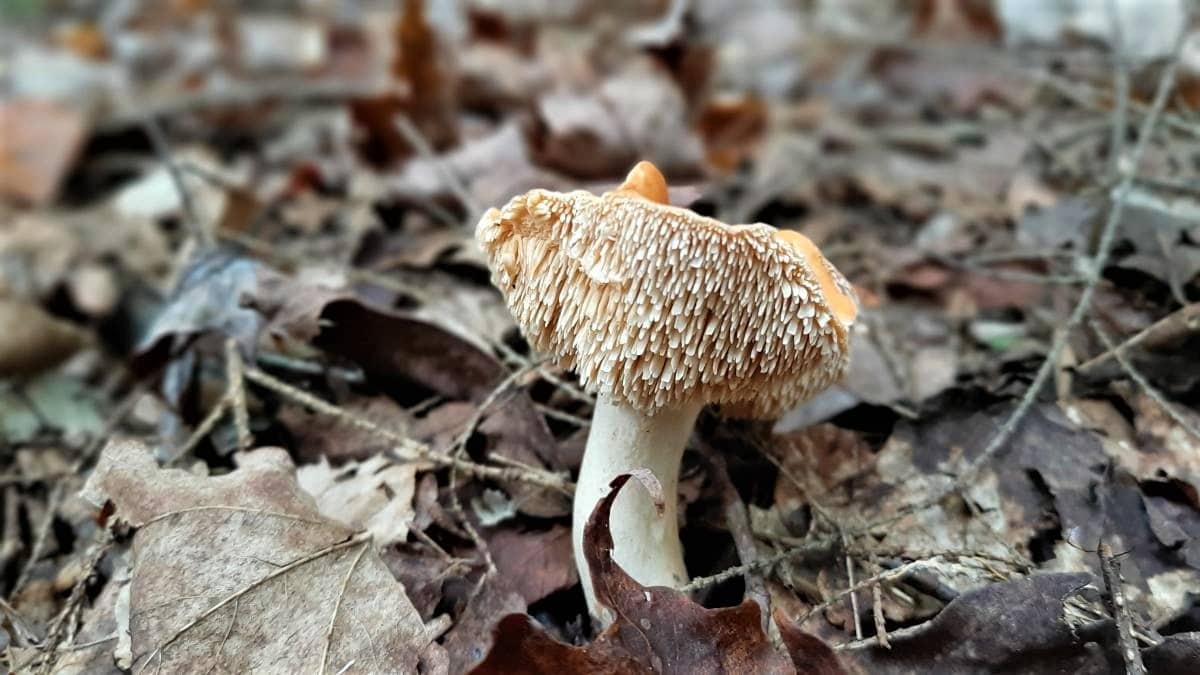
Hedgehogs are late summer to fall fungi, depending on the location. In North America, they appear on the east coast from June to November. However, in the Pacific Northwest, some only start appearing in December.
Hedgehogs and Chanterelles
Hedgehog fungi are in the same family as chanterelles. In fact, from above, it is easy to confuse an orange-colored hedgehog with a chanterelle! Hedgehog caps are smooth, often irregularly round, and a little lumpy, which also happens with chanterelles. And many species of hedgehog mushrooms have that telltale apricot scent that is associated with chanterelles.
The distinction between the two is easy, though. All you have to do is look on the undersides to see if the mushroom has teeth or false gills. Don’t be disappointed if it’s not a chanterelle – take that hedgehog home and cook it up. You may find that you prefer it to the much-exalted chanterelle.
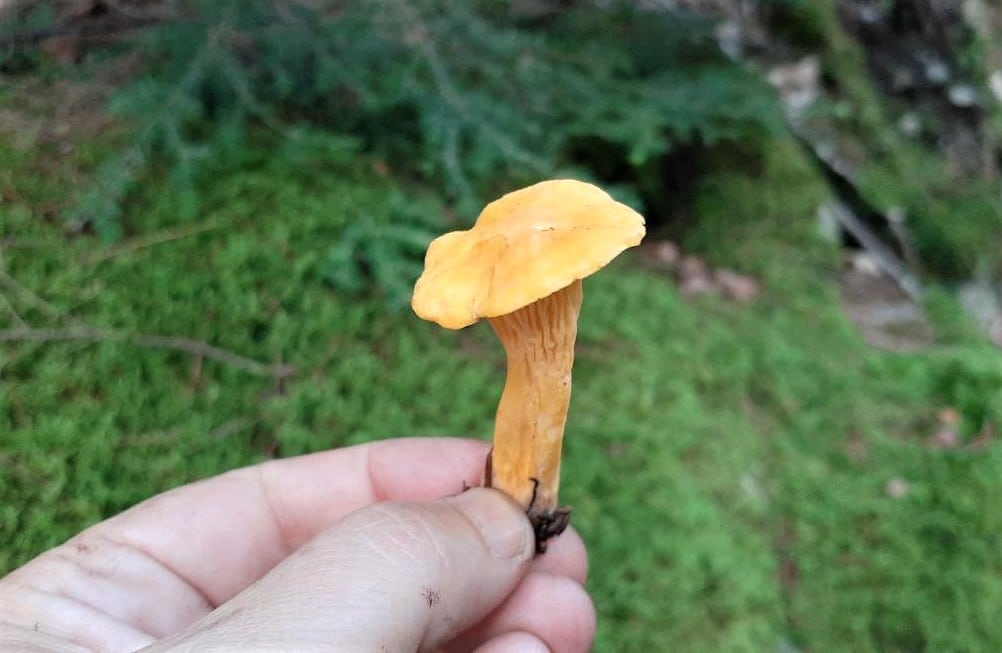
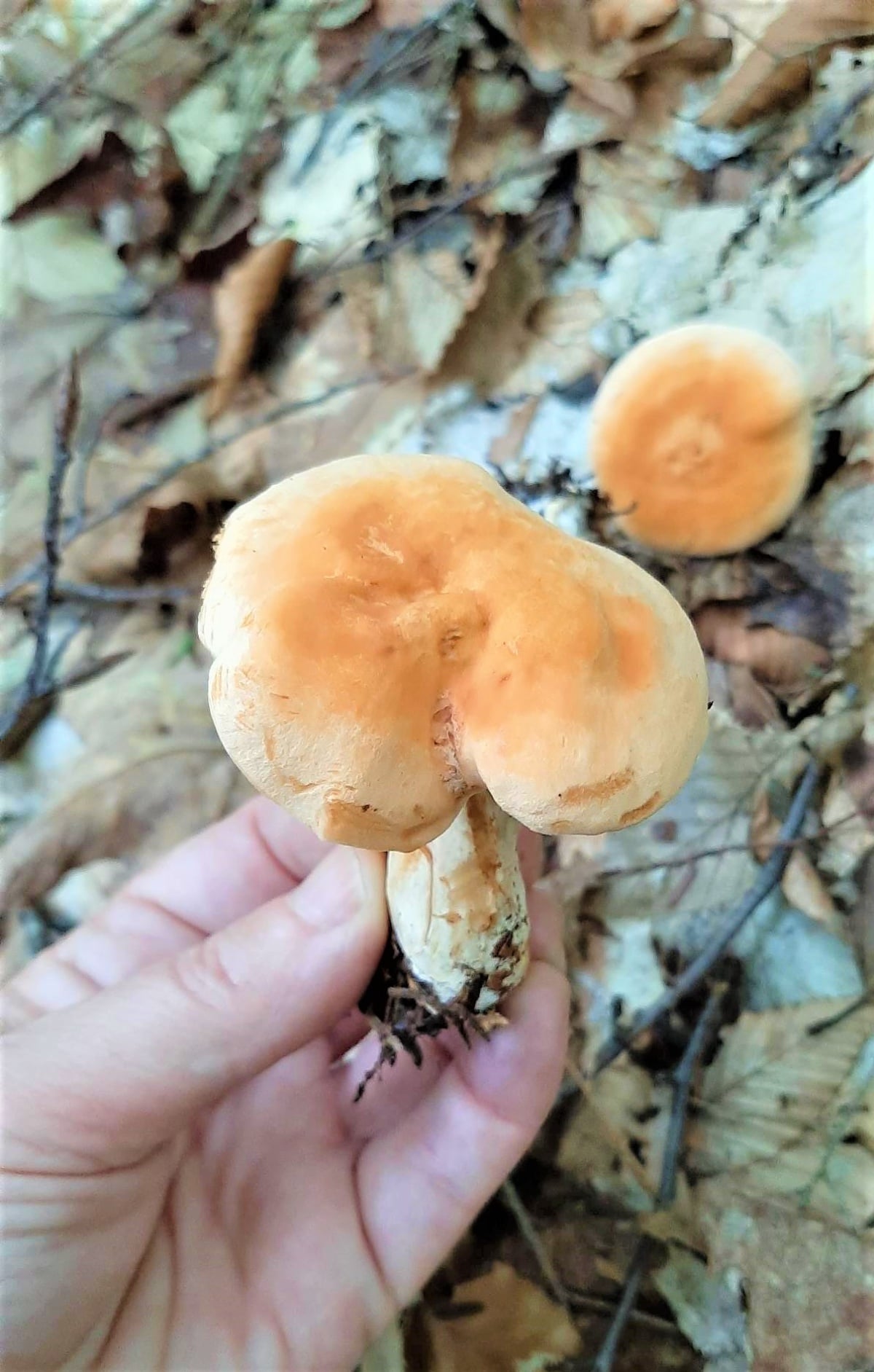
Where do Hedgehogs Grow?
Hedgehog mushrooms grow around the world, including North America. They are widespread in Europe, though some are now vulnerable due to overharvesting and habitat destruction.
Science is still determining how many Hedgehog species exist. Traditionally, only 7 were recognized, but a 2016 research paper put the number closer to 31. As of 2018, there were 49 identified species worldwide.
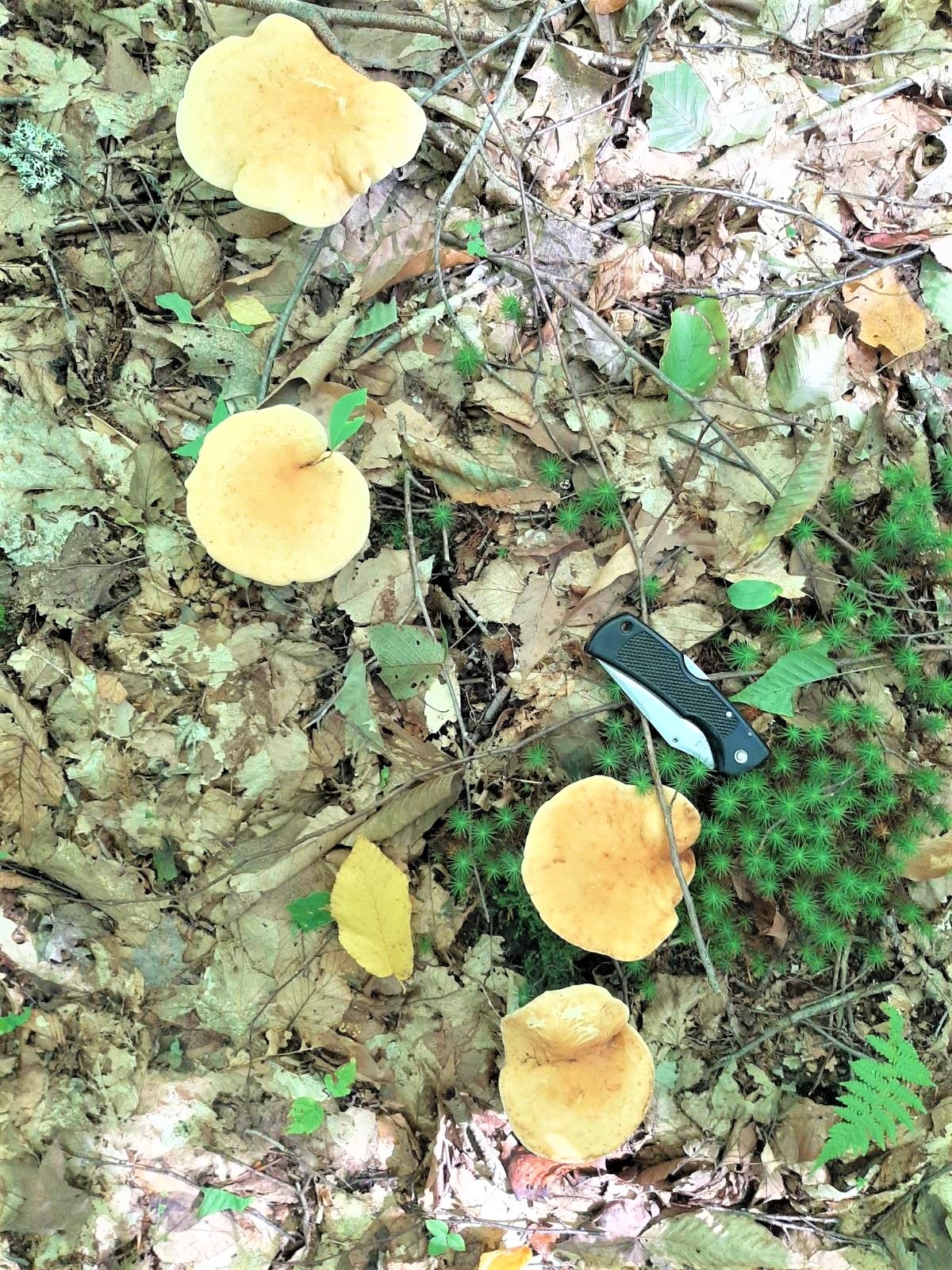
In North America, there are potentially 19+ different Hedgehog types. The taxonomy of North American fungi gets really fascinating and frustrating at times! Some aren’t clearly defined and don’t have proper names yet, so accurate identification can be a little tricky.
However, with Hedgehog mushrooms, that’s okay. If you find a pale white, tan, or peachy little mushroom with little teeth under the cap, it is almost certainly a Hedgehog. This article outlines the known species, but it will certainly (hopefully!) need to be updated at some point as more clarification is available.
How To Find Hedgehog Mushrooms
Season
Again, seasons vary with species. Some east coast species emerge in June, but the majority are late-summer or fall mushrooms. West coast species fruit in early spring and late fall into winter. Basically, keep your eyes open for these little gems all the time!
Description
Hedgehog mushrooms are easiest identified by cap color, size, and presence of spines instead of gills. They are generally small mushrooms, rarely getting larger than 6-8″ in diameter. Caps are creamy white, tan, lightly orange, or deep orange.
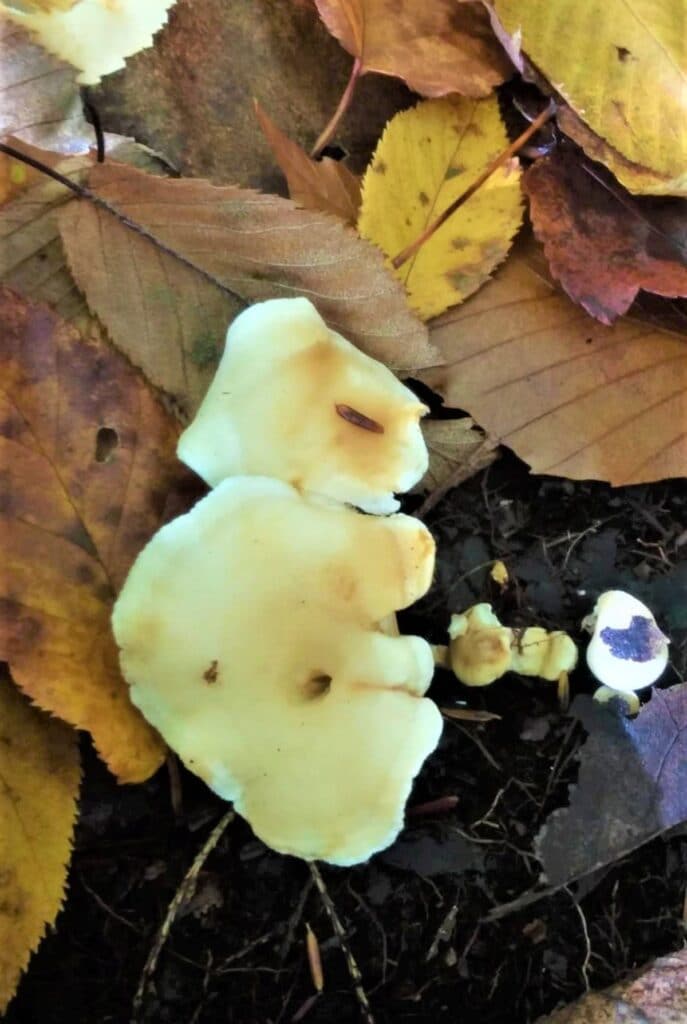
The caps are round or irregularly round, and the edges are wavy or rolled inwards. Younger specimens tend to have inward rolled cap margins that become convex or concave in maturity. The cap surface is dry, and there may be some cracking on the top of older types.
Some caps are thick and dense, looking like little bread buns lying on the ground. Other species have thin cap flesh and are generally diminutive in size. The caps are often pocked or lumpy, though this does vary a bit with species and maturity.
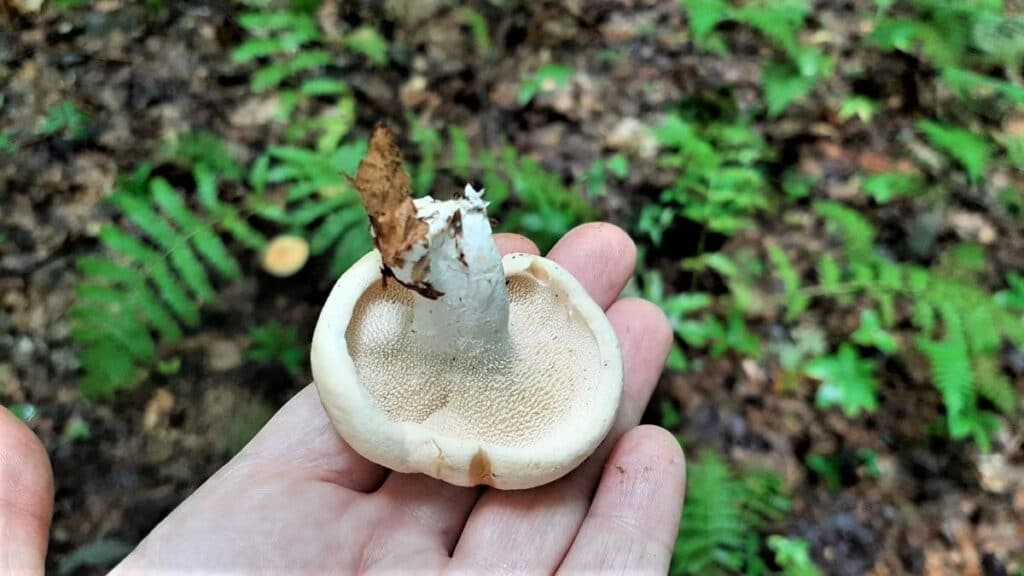
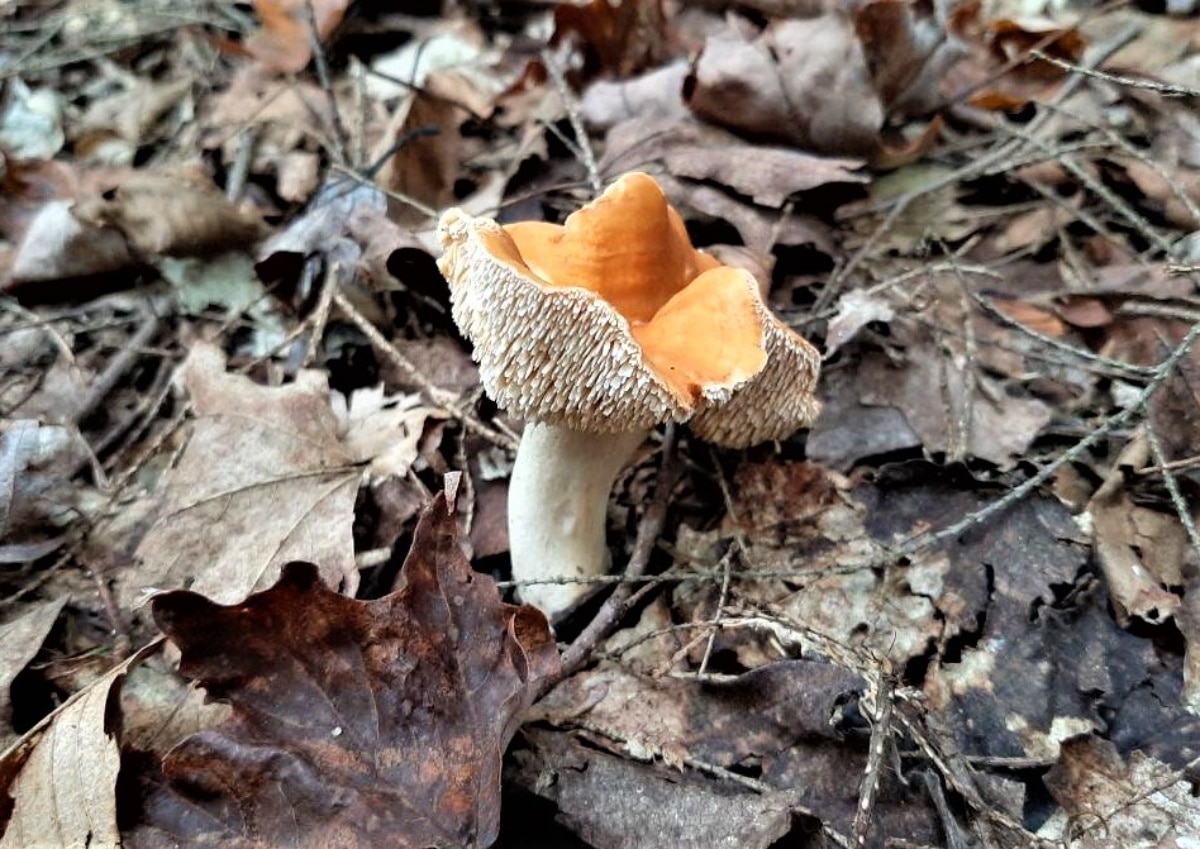
Hedgehog stems either attach centrally to the cap or are a bit off-center. They are slender or thick, depending on the species, and usually a lighter color or the same color as the cap.
Underneath the cap is a dense covering of thin downward-hanging spines or teeth. Depending on species and maturity, the spines may run down the stem a little. Spines are brittle and will break off in handling.
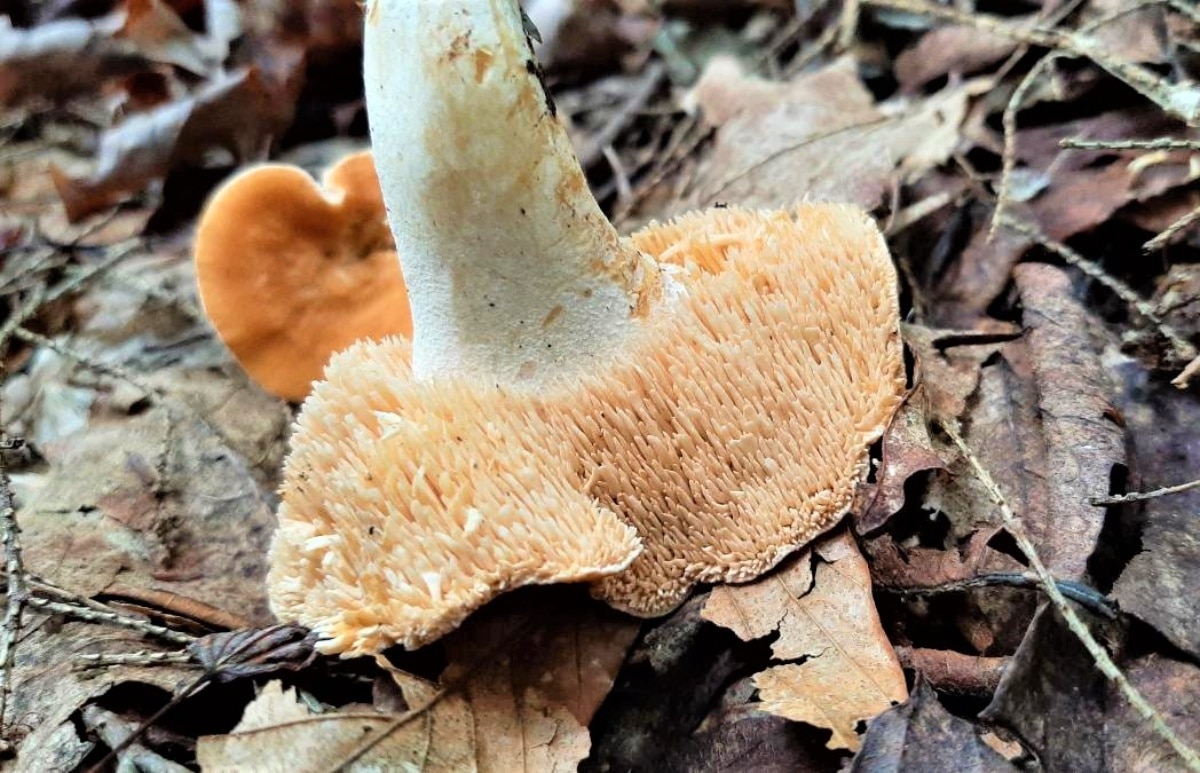
Hedgehog mushroom flesh is pure white, dense, and also brittle. Some species bruise to yellow or brown, but most retain their white coloring. The brittle flesh is another good way to verify you’ve found a hedgehog. Make sure the specimen has spines, then try to break the cap. If it almost crumbles in your hand, that’s a hedgehog! All the lookalikes have tough, corky, or leathery flesh that does not break easily.
The spore print of a hedgehog is white.
Habitat
Hedgehog’s preferred habitat is split between the east coast and west coast species. The majority of east coast hedgehog mushrooms grow in mixed forests, with a preference for conifer-heavy locations. West coast hedgehog species mostly grow with just conifers.
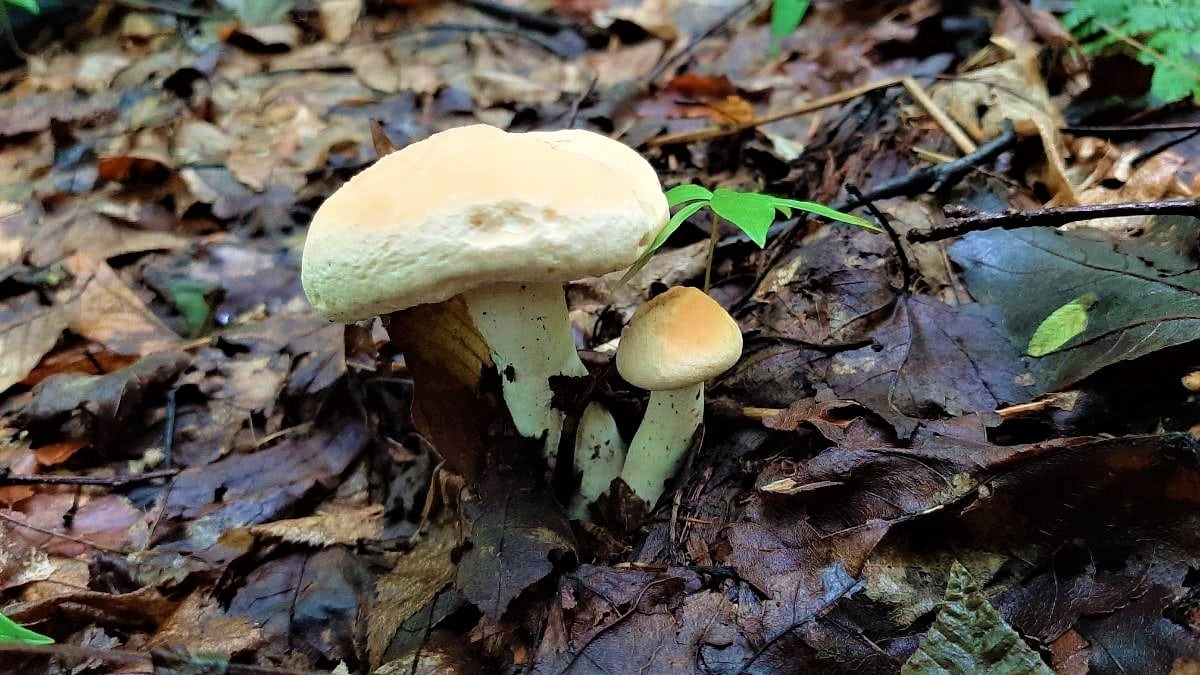
They are mycorrhizal, meaning they develop symbiotic relationships with trees. The fruiting bodies always grow from the ground, surrounded by leaf litter. Usually, they grow in scattered groupings across the forest floor but will also grow singly. If you find one, definitely look for more.
Sometimes hedgehogs appear as fairy rings, too.
On The Lookout
As you’re out walking in the woods, keep an eye out for small tan, peach, white, or orange-brown capped mushrooms similar to chanterelles. Look on the ground for the telltale humps or bumps of a mushroom about to push up out of the leaf litter.
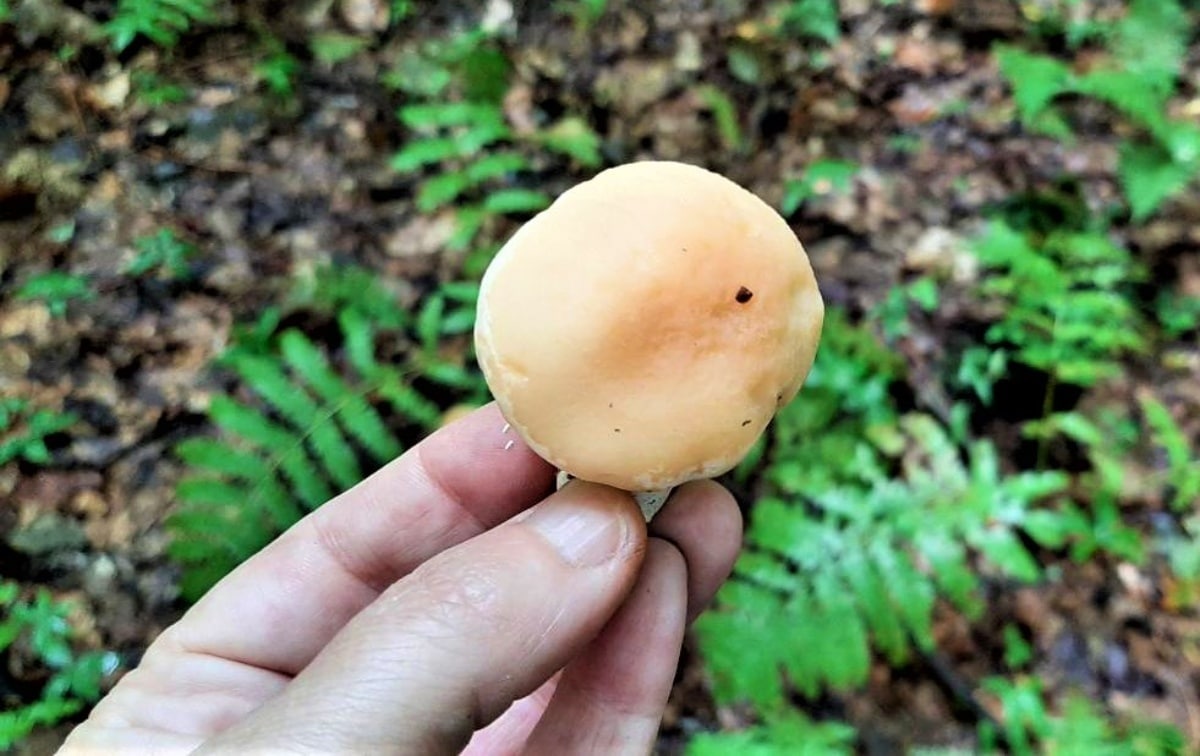
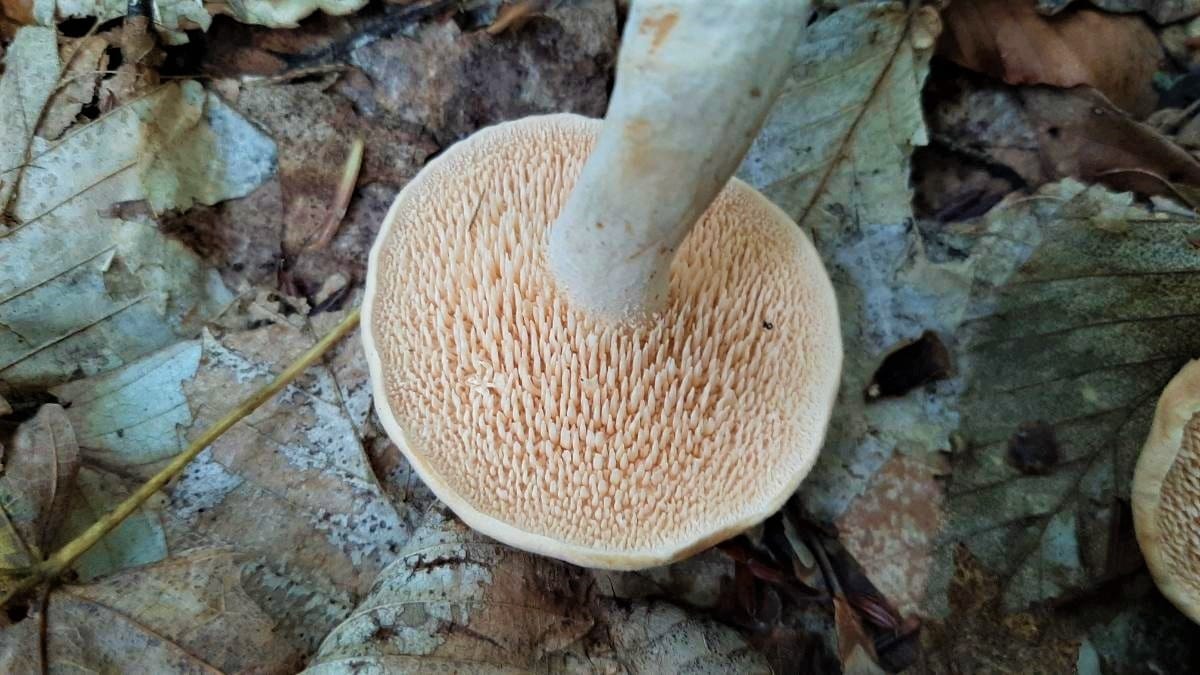
Hedgehogs are an easy mushroom to overlook, which is probably one of the reasons they are not hugely popular or well-known. Their muted coloring and small stature make them blend into their surroundings. It isn’t until you turn the fungi over and see the spines that you know it’s a good foraging day.
Most foragers don’t go out looking specifically for hedgehog mushrooms but are happy to discover a bunch while out hunting the more elusive chanterelles or black trumpets. If you find a patch of hedgehogs, mark it down. You’ll find them in the same location for years.

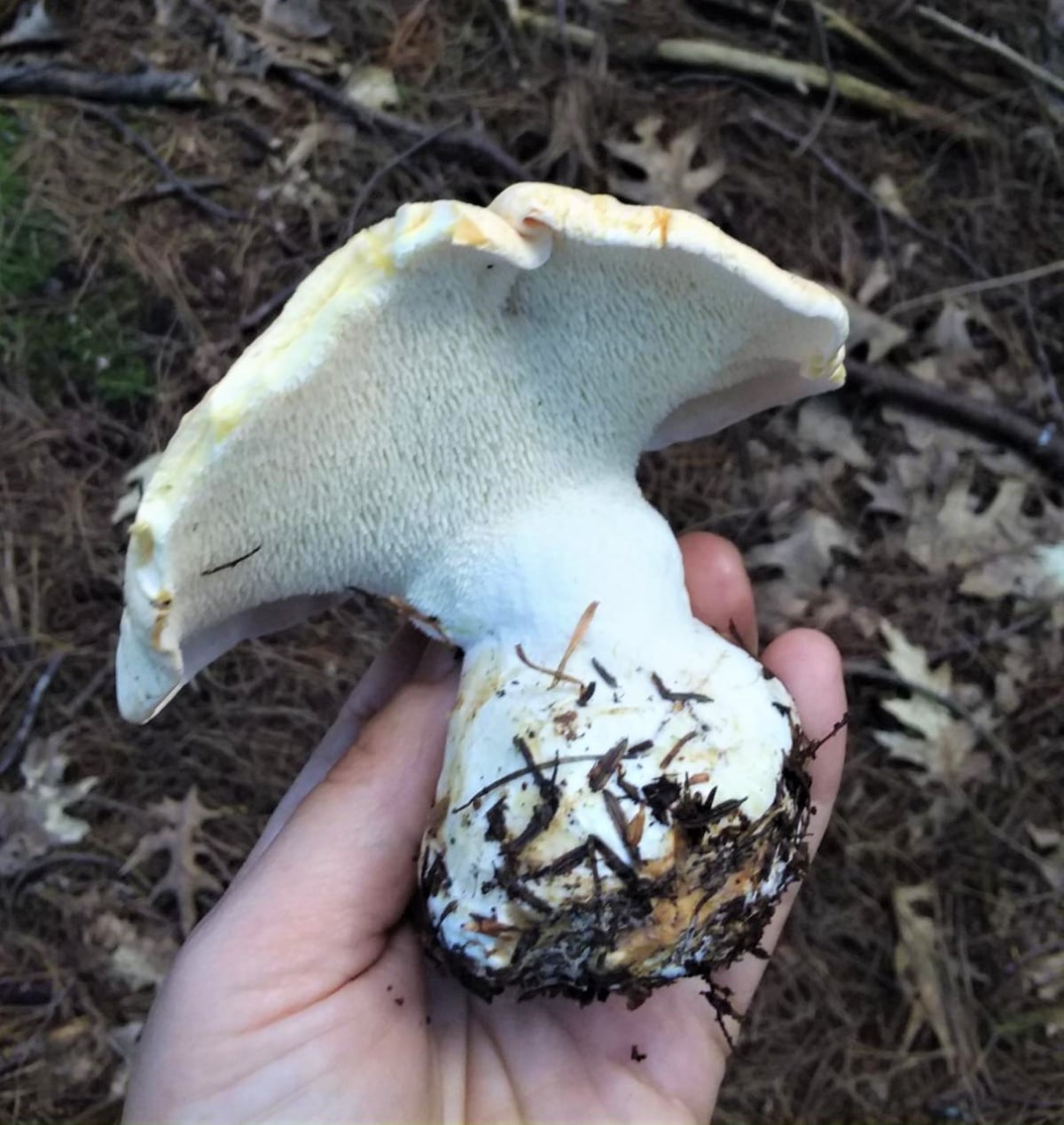
Hedgehog Mushroom Lookalikes
Hydnellum – This species has teeth or spines instead of gills, just like hedgehogs. However, their flesh is corky or leathery, very tough, and they have a centrally attached stem. Many of them are very darkly colored, either brown or black. There are 51 species worldwide, but all you have to do is handle the flesh to know you don’t want to eat it unless you like eating leather.
Phellodon – Another member of the tooth mushroom family tree, Phellodons are easy to tell apart from hedgehogs because they have very dark caps – deep brown to black. They also have very short to non-existent stems.
Phellodon fungi are dense and leathery or cork-like when dried out. They are commonly known as cork-hydnums (cork-toothed mushrooms). While they have a pleasant fragrance, this is not a mushroom you’d even want to try eating.
Sistotrema confluens is a newly identified polypore occurring in North America, Central America, and Europe. It may have short spines on the undersides or smooth tubular pores. The specimens with spines resemble hedgehogs. It’s not too difficult to determine what you have found, though. Polypores grow on trees, and this one grows on dead hardwoods and conifers. Hedgehogs never grow on trees.
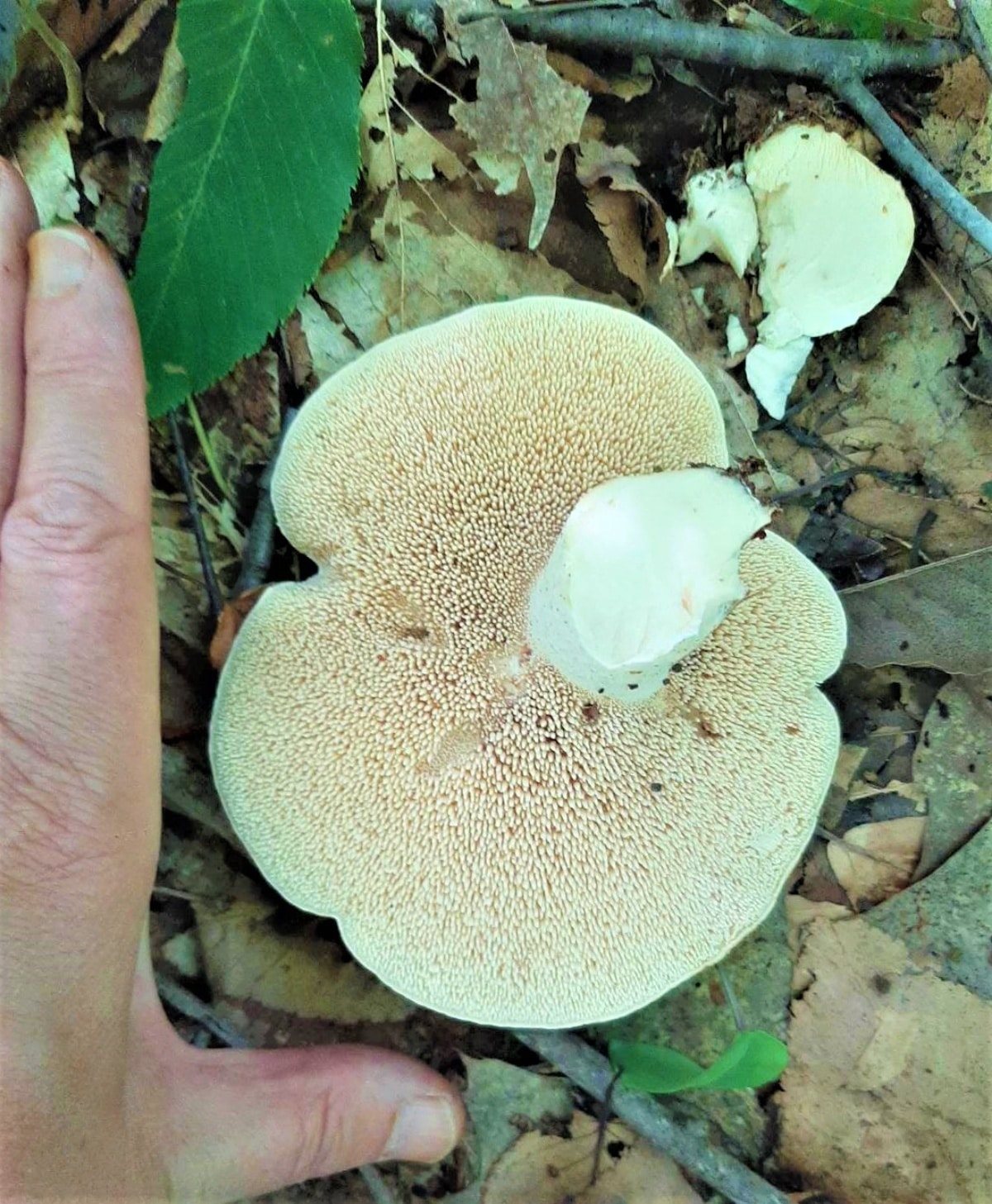
How to Harvest Hedgehog Mushrooms
Either gently pluck the mushroom from the ground or use a knife to cut it at the base. There is much controversy around proper picking etiquette – whether to pick or cut. A long-term (30+ year) study conducted in Switzerland with 500 mushroom species demonstrated that following year yields were not impacted by the harvesting method used. So, use your preferred method; it’s fine.
Never pick an entire patch clean — leaving some to spread spores for the following year is good practice. It’s essential to sustain and renew mushroom patches.
It’s best to keep picked hedgehogs separate from other mushrooms and in a basket with hard sides. The problem with hedgehogs is that they are super brittle and will break apart into a hundred pieces if jostled around too much (yes, this is a learned experience!). Do not put them in the same bag with larger or heavier mushrooms.
Hedgehogs like a delicate treatment.
Cooking with Hedgehog Mushrooms
Hedgehog mushrooms have a dense, meaty, mushroomy flavor with just a hint of sweetness. They can be cooked much like chanterelles since they are in the same family. Hedgehogs are excellent fried in a bit of butter and garlic.
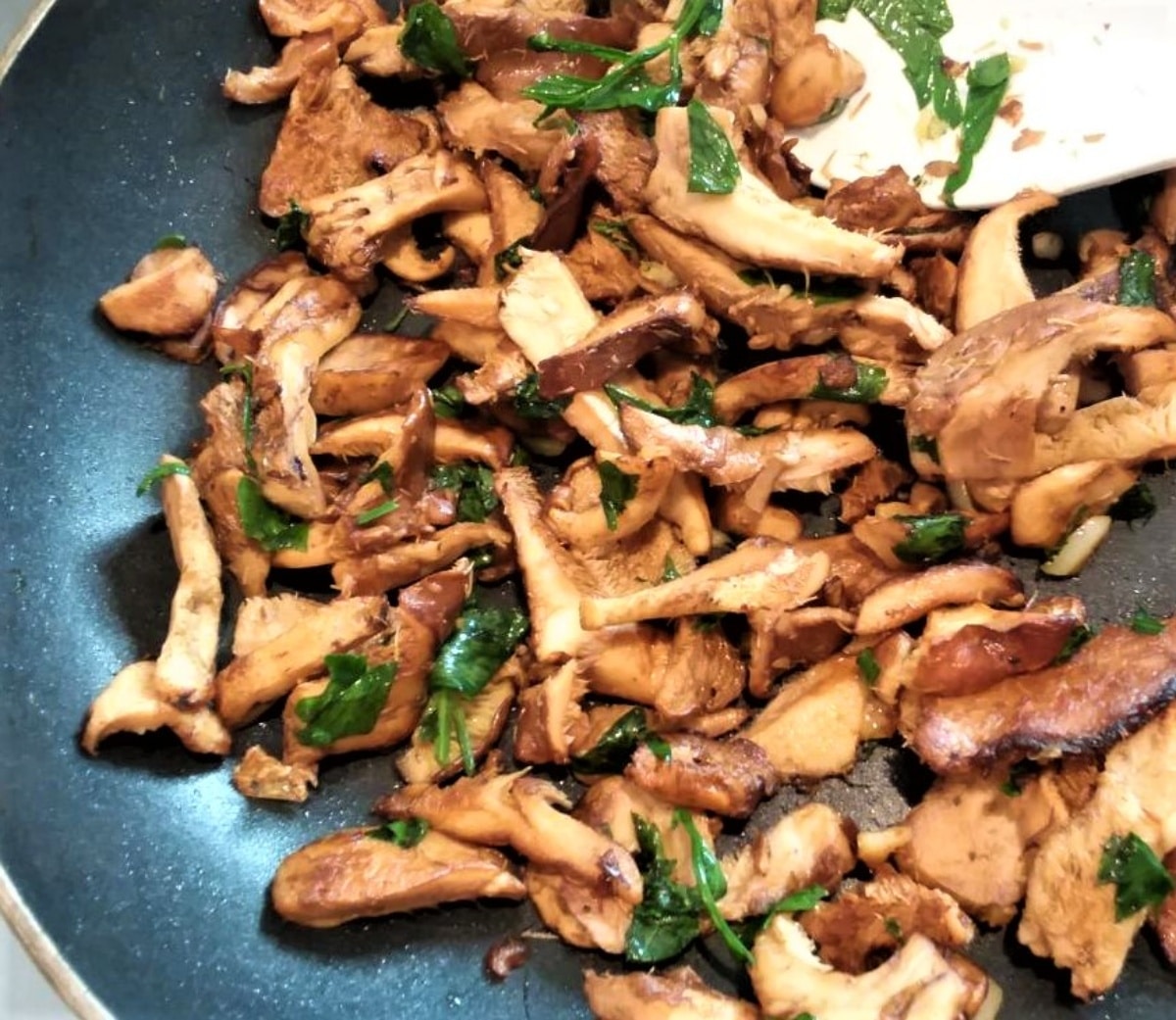
These mushrooms hold their shape and retain their meaty texture. In fact, cooking resolves the brittleness of the flesh. The heat softens and relaxes the mushroom to create a tender, succulent treat.
Cleaning hedgehog mushrooms is a little time-consuming but not that bad. The tiny spines should be lightly scraped off. There’s nothing wrong with the spines, but usually, there is grime in there, and it is impossible to clean without breaking them.
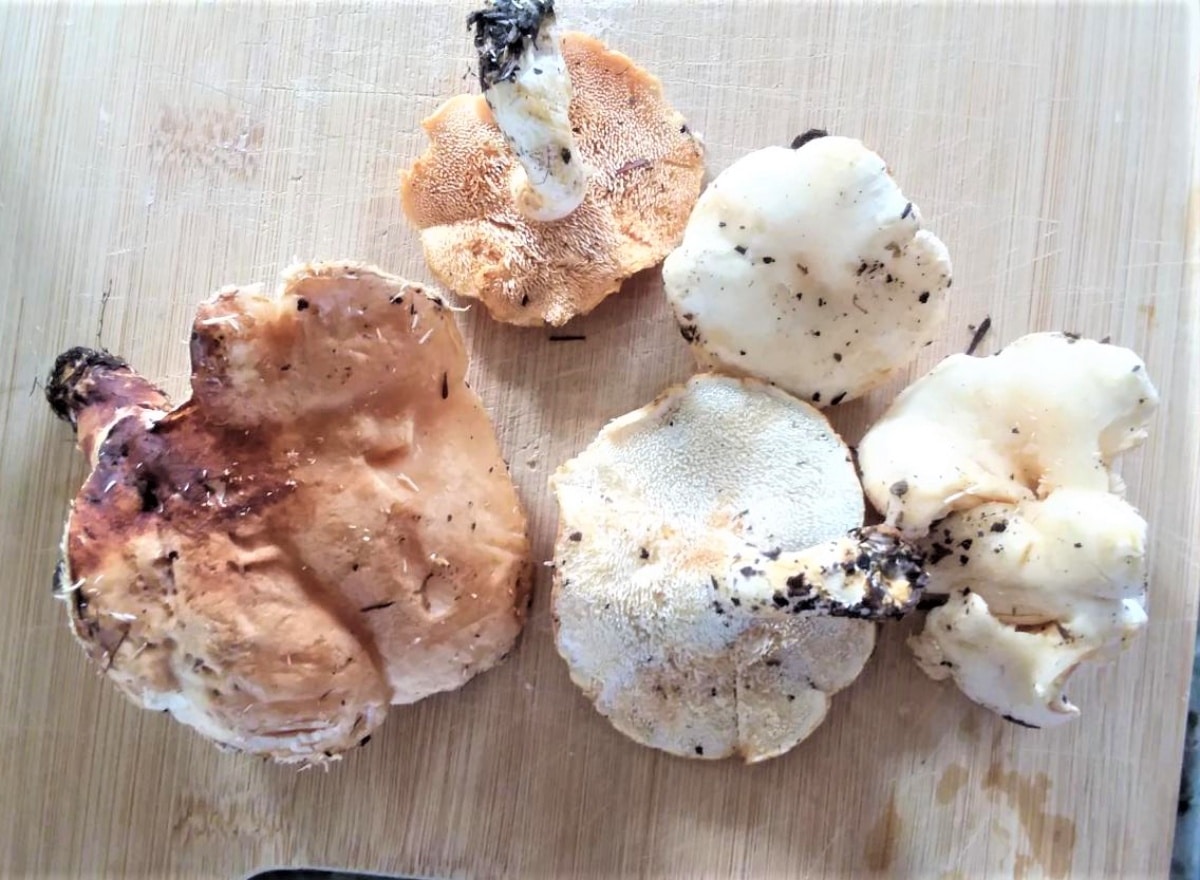
To avoid any dirt or gravel ending up among your cooked mushrooms, take a spoon and lightly scrape the spines off. They remove easily. I usually do this under running water, so the spines will just wash away. The tiny teeth have a way of ending up all over your cutting area, hands, and tools if they’re dry while being scraped off.
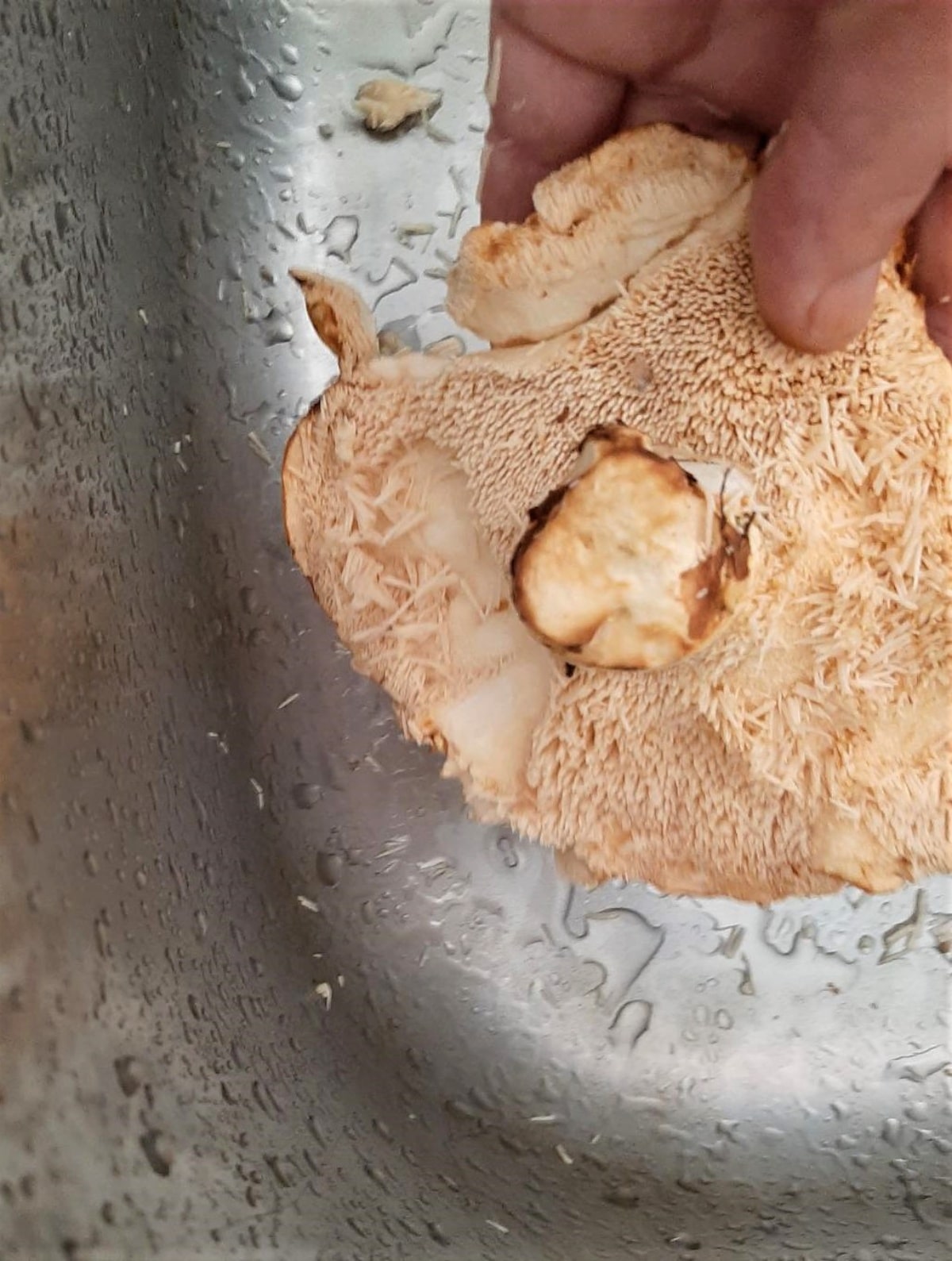
The stems are also usually a bit dirty, with debris that doesn’t remove easily. Either use the spoon to scrape off the dirt there, too, or cut them off. Hedgehog stems are as dense and delicious as the caps, so if you can retain them, you should. However, sometimes they are too dirty and difficult to clean or break off when you’re doing it and should be abandoned.
Looking for recipe ideas? Check out our in-depth guide: How to Prepare Hedgehog Mushrooms: Cleaning, Prepping, and Cooking.
Ways to Prepare Hedgehog Mushrooms
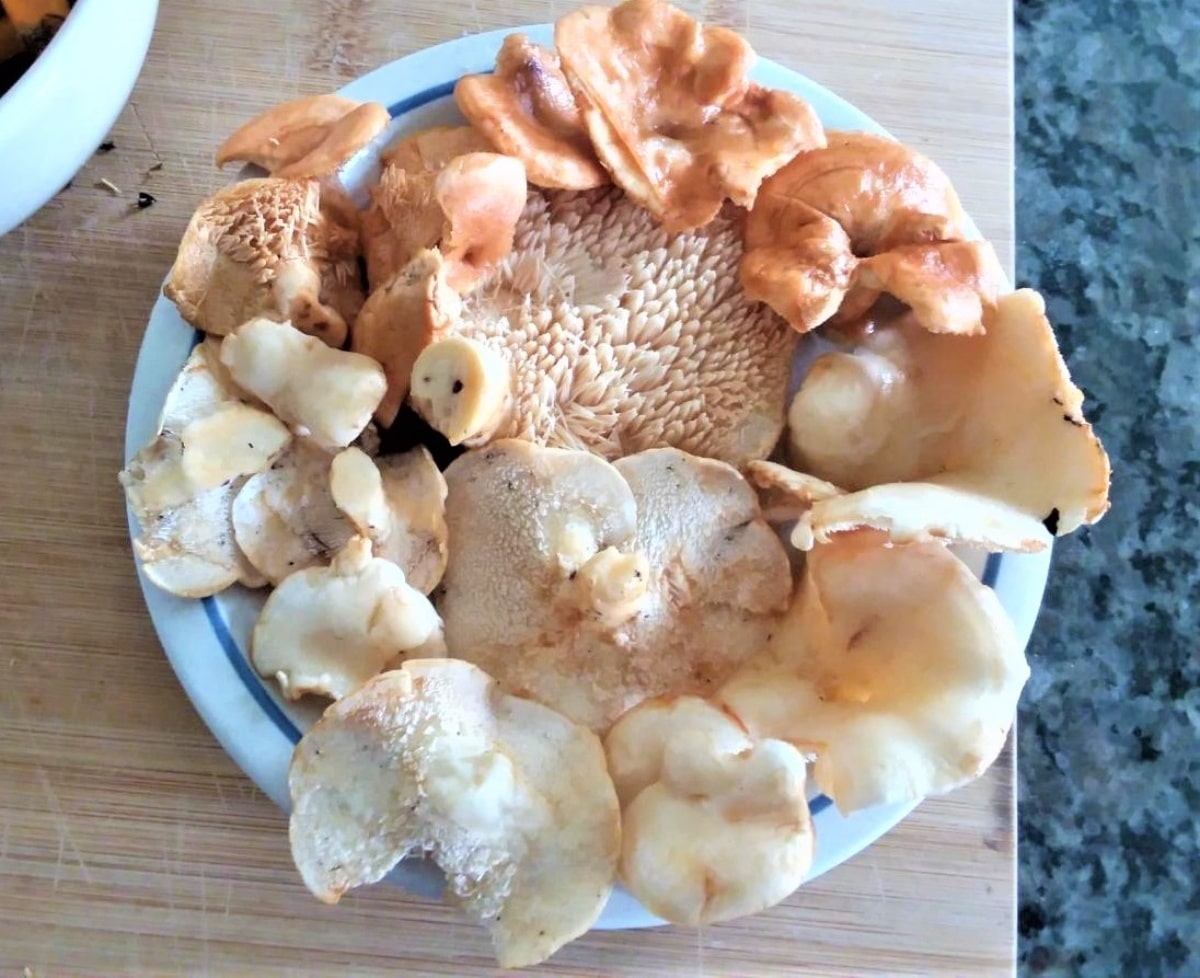
- Sauteed
- Added to soup and stews
- Grilled
- Pickled
- Hedgehog mushroom torte
- Roasted whole with herbs
- Hedgehogs on toast
- Pot pies
- Stir-fries
- Added to pasta
North American Hedgehog Mushroom Species
Previously, many hedgehog species were classified as Hydnum repandum or Hydnum rufescens. However, recent studies show that these two species are almost entirely confined to Europe. You will still see these designations commonly used in mushroom foraging and field guides for North America. Newer guidebooks should reflect the new North American names.
There are approximately 12 hedgehog species on the East Coast, 5 on the West Coast, and 2 that grow across the country.
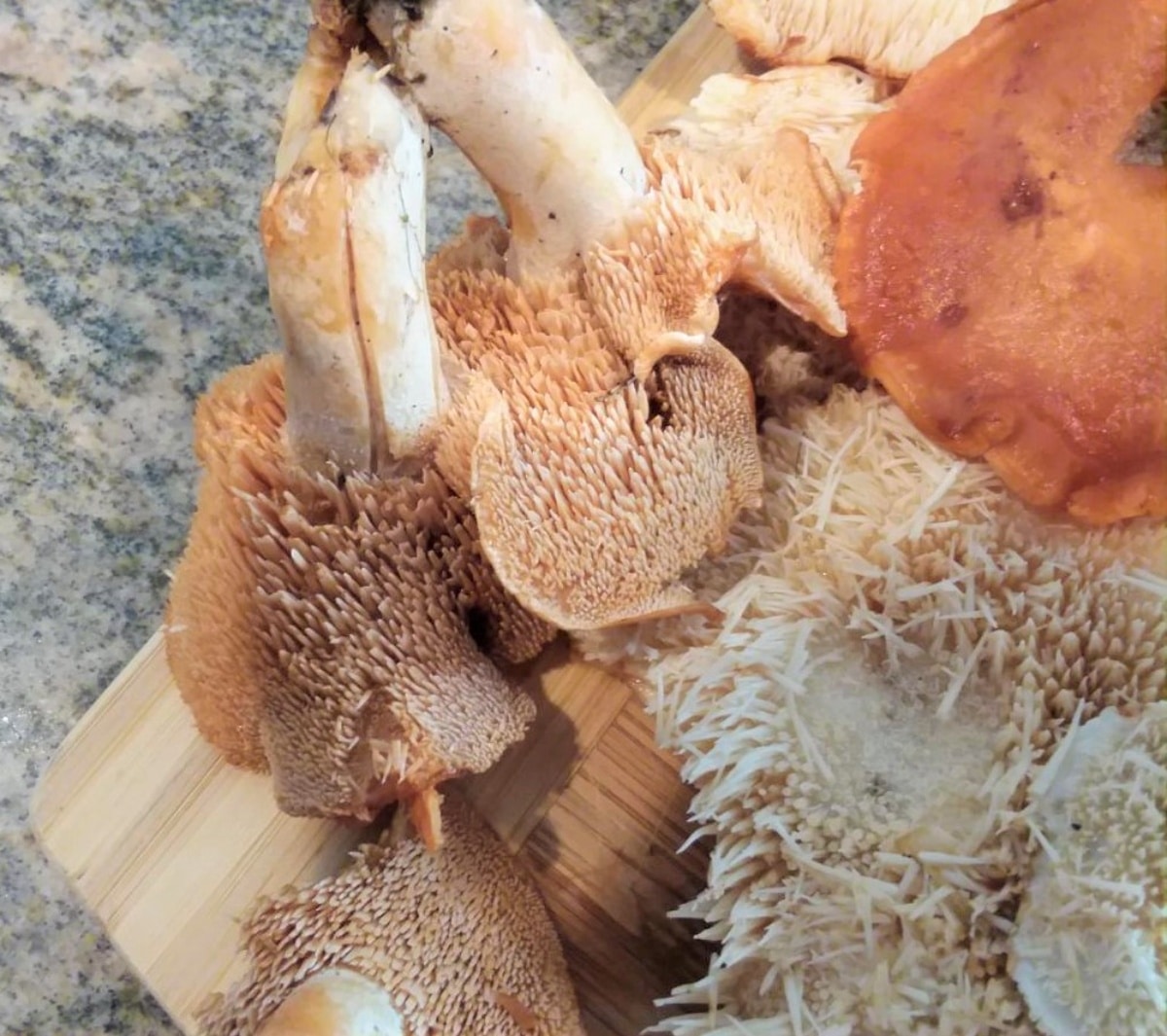
East Coast Hedgehog Species
Hydnum aerostatisporum (2017) – This is a commonly encountered species in eastern North America. The cap of this hedgehog is irregularly rounded, 1-4 inches wide, and brownish orange. It becomes funnel-shaped with age and often cracks. The stem is 1-3 inches long, cream to tannish-orange. This mushroom has a mild sweet that intensifies when stored in aluminum foil. Its taste is mild. It can be found among hardwoods or in mixed forests from June through October.
Hydnum alboaurantiacum (2018) – Looks very similar to H. albidum, except it stains bright orange within minutes. It has a mildly sweet and fruity scent. H. alboaurantiacum only grows in the southeastern US and is found in mixed woods from May through August.
Hydnum albomagnum (1901) – This species is known as the giant hedgehog. Its cap is 2-5 inches wide, irregularly rounded, and often pitted. It starts out creamy white with patches of bright white, then turns light tan. Leaf litter adheres easily to the caps, more than with other species, so this is a good way to differentiate between them.
Giant hedgehog spines are white or creamy white. The stem is 1-2 inches long, smooth, and doesn’t usually bruise. This hedgehog’s flesh color doesn’t change when cut. It has a mild fruity odor that intensifies after being stored in aluminum foil.
These hedgehogs grow in the eastern United States in mixed woods forests from September through December.
Hydnum canadense (2018) – This is a very small hedgehog with an orange cap, cream-colored teeth, and a cream-colored stem. The cap doesn’t get more than 1-inch wide, and the stem is usually around an inch long as well. It has a mild odor and taste. This hedgehog is found in high-elevation conifer forests in eastern North America and Canada from August to September.
Hydnum cuspidatum (2018) – This species of hedgehog mushroom grows in the southeastern and upper midwestern United States. It features a 1-2.5 inch dull or deep orange-brown oval cap and tan to peachy-brown 1-2.5 inch stem. The scent is usually not distinctive, and neither is the taste. It appears from June to October in deciduous or mixed forests.
Hydnum ferruginescens (2017) – A small rust-colored hedgehog mushroom, H. ferruginescens is a southeastern United States species. The cap gets no bigger than 2.5 inches wide, is round, and becomes depressed in the center. Its stem is .5-2 inches long and white or cream-colored. Both stem and cap bruise light orange when handled. It doesn’t have a strong scent but tastes mildly fruity. This hedgehog grows among mixed forests in September.
Hydnum mulsicolor (2018) – Native to the eastern United States and Central Europe, this hedgehog species is noticeable for its diminutive size and bright orange to tan cap. The cap is 1-2 inches round and convex to funnel-shaped. H. mulsicolor stems are 1-2 inches long and creamy white – sometimes, they have small cottony patches. This hedgehog has a mild scent, but its taste is not distinctive. It grows in mixed or deciduous forests from July to September.
A note of interest; this is the only known Hydnum species to grow in eastern North America and Europe.
Hydnum quebecense (2018) – This hedgehog species appears to prefer sphagnum bogs, conifers, and beech trees. It’s also a very tiny hedgehog, with a cap averaging ¼”-3/4″ wide. The caps are rounded, convex, and tan or reddish-brown.
The stem is longer than the cap is wide, ½”-2 inches tall, and creamy white or light orange. These hedgehogs are found in the eastern United States and Canada in July and have a mild odor and taste.
Hydnum subconnatum (2018) – This is a peachy-orange to reddish-brown hedgehog with a rounded cap and white to tan stem. The cap is ½”-3 inches wide, and the stem is ½”-2.5 inches long. H. subconnatum grows in the southeastern United States from July to December in low elevation mixed forests. It has a mild sweet taste and odor.
Hydnum subtilior (2018) – The round cap on this hedgehog ranges in color from light cream to yellow to creamy orange. It is 1-4 inches wide and stains a rusty orange-brown when handled or cut. The stem is 1-3 inches long – it is usually longer than the width of the cap on individual species. This hedgehog has a mild, sweet scent and taste. It grows among hardwoods or mixed forests in the southeastern United States and Mexico from June through August.
Hydnum subolympicum (2018) – This hedgehog has a 3-5 inch wide, round cap that stains a rusty brown when handled. Cap colors range from dull orange when young to creamy white or peachy orange when older. The stem is 1-4 inches long and also stains rusty brown when cut or handled. H. subolympicum smells fruity like apricots, but the taste is often sometimes bitter or peppery. It is found in eastern North America among hardwoods or mixed forests from August to October.
Hydnum umbilicatum (1902) – Widespread across the eastern United States, this creamy orange to brown hedgehog is usually found with conifers or mixed forests with conifers. The caps are 1-2 inches wide, irregularly round, and lightly depressed – most look like they have a belly button. Stems are 1-3 inches long and white or tan. It has a mild scent and mild, nutty flavor. H. umbilicatum is the species most orangey eastern hedgehogs were initially placed under.
Hydnum vagabundum (2018) – Looks very similar to H. subolympicum, except it is paler, and the cap is more irregular and lobed. It also is similar to H. albomagnum but can be differentiated because H. albomagnum always has large amounts of leaf debris on its cap. This species is found in mixed forests in eastern North America and Central America. It doesn’t have a strong scent but tastes mildly sweet and nutty.
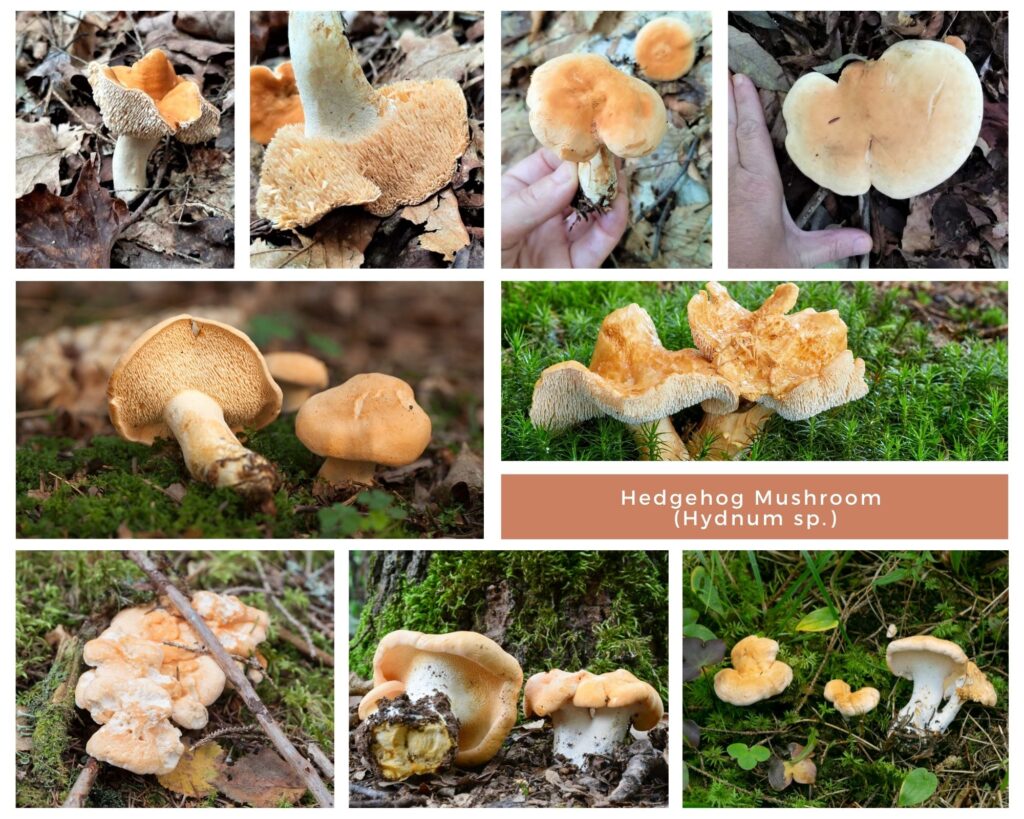
West Coast Hedgehog Species
Hydnum melleopallidum (2018) – This tiny hedgehog with the pale honey-colored cap grows among conifers in western North America and Canada. The cap is .5-1.5 inches wide and round. The stem is also .5-1.5 inches long and white but bruises yellow-brown when handled.
Hydnum neorepandum (2018) –This is the West Coast hedgehog species that resembles the common European hedgehog. Formally, this species was called H. repandum. It has an orange-pink or cream-colored cap 1.5-4.5 inches wide. The stem is 1-4 inches long and white. H.neorepandum grows with conifers, usually around spruce.
Hydnum olympicum (2018) – Found in old-growth conifer forests in the Pacific Northwest, H. olympicum has a tan cap and white stem. The cap is 1-2.5 inches wide, while the stem is 1.5-2.5 inches long. This species may be the same as H.neorepandum.
Hydnum oregonense (2018) – This is a western North American hedgehog that grows with conifers, specifically firs, pines, and hemlocks. It is also found in mixed forests with tanbark oak trees. It emerges in December through April. This hedgehog has small caps less than 2 inches wide, and the stem is the same length. The cap is pale brown to orange-brown with an indented center, like a belly button. The stem is white but stains tan.
Previously, H. oregonense was placed under the name H.umbilicatum. The recent studies show that H. umbilicatum is an east coast species and so, H. oregonense is the new name for the west coast species.
Hydnum washingtonianum (1894) – This is a tiny hedgehog with 1.5 inch wide caps and 1.5 inch long stems. The cap is pale orange, slightly depressed in the center, and smooth. The stem is also pale orange. In December, H. washingonianum grows in western North America and eastern Canada among conifer trees. This species was formerly named H. repandum, which is now considered a mainly European species.
Hedgehog Species on Both Coasts
Hydnum albidum (1887) – Known as the white hedgehog, H. albidum has ½ – 2 inch wide caps that are either round or kidney-shaped. The caps are bright white, and then they turn creamy or peachy as they age. They are often bumpy or mottled-looking. White hedgehog spines are very short and also white or creamy white.
Its stem is 1/2″-2 inches long and very slowly stains to orange-brown. It can take an hour or more. It tastes pleasant and mild, though sometimes spicy. Oddly, when the white hedgehog is stored in aluminum, it develops a strong apricot scent.
White hedgehogs grow across North America in mixed woods from June through September.
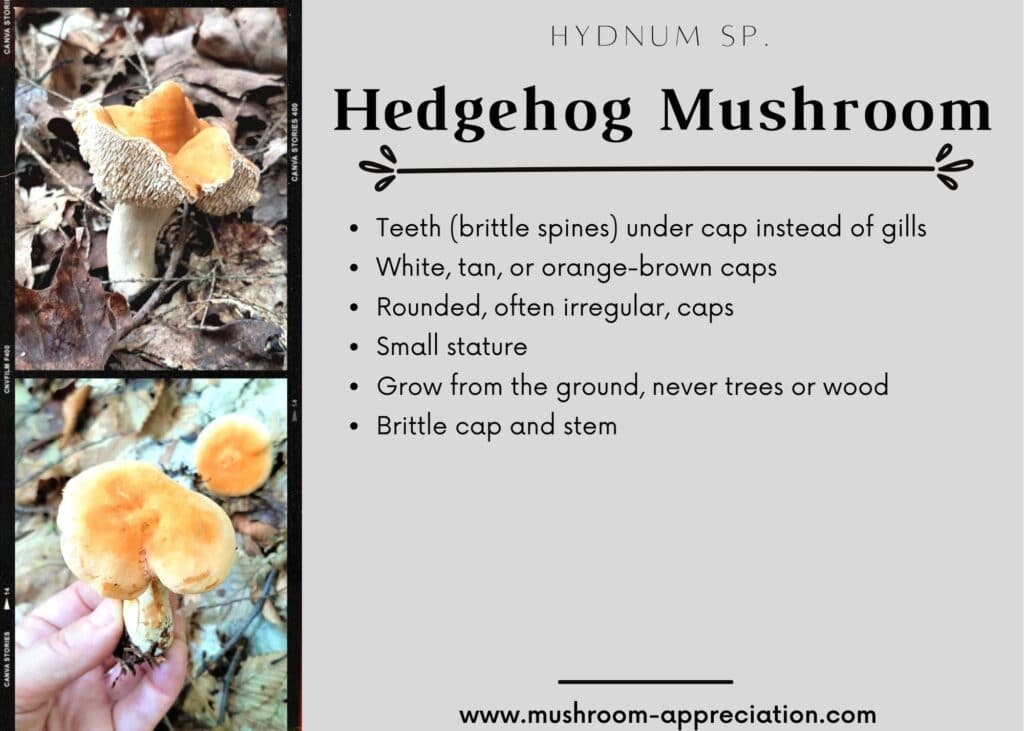
Hedgehog Mushroom Common Questions
Can I grow hedgehog mushrooms?
No. There is no method to cultivate hedgehogs at the moment. Since they are mycorrhizal, it is too complicated to recreate that relationship to get them to fruit.
Are all hedgehog mushrooms edible?
Yes! However, some may be bitter, so first, do the nibble test. It’s awful to cook up a batch of nice-looking mushrooms only to be taken unawares by their bitterness.
What do hedgehog mushrooms taste like?
Hedgehog mushrooms taste nutty and mushroomy with a hint of sweetness or fruitiness.
Does the hedgehog mushroom have lookalikes?
Yes, there are several. However, none are poisonous, so you don’t have to worry about that. Consult the lookalikes chapter further up to see descriptions of the lookalikes. Most are other toothed mushrooms. They also have spines instead of gills, but they look quite different. Hedgehog mushrooms are considered one of the safest mushrooms to forage.





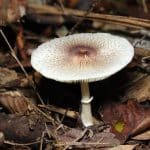
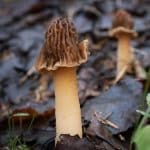
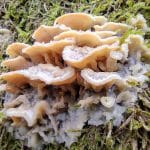
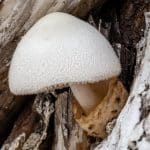
Florence says
Great info. I am a new at foraging mushrooms and this post is very informative.
Jenny says
Thank you and happy foraging!
KJ Hansen says
Thanks for sharing your expertise! This is very helpful.
Jenny says
You are very welcome!
Rachel says
Really helpful, thanks for taking the trouble to go into so much detail. My dad taught me mushroom hunting as a child and used to say ” a little knowledge is a dangerous thing”, which is why it’s so good to have so much info here.
Jenny says
Excellent saying! Glad you find the site useful :-). Hope there is some excellent foraging in your near future